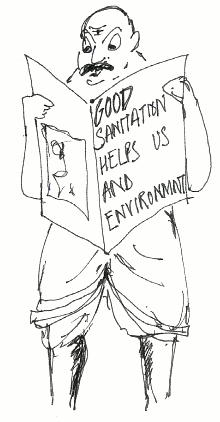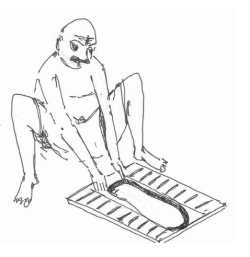|
|
Credits
>>>
|
We are
very fortunate that there was no major disease outbreak after the
December 2004 tsunami which devastated coastal villages in the 13
districts of Tamil Nadu. Nonetheless, it would be prudent to keep emphasising the need for good sanitation in the post Tsunami Reconstruction work. Over the past three years, several interesting and significant programmes and events related to sanitation have taken place -- Children's sanitation parliament, 250 ECOSAN toilets in a single village, SHG members taking charge of  a pay-and-use DEWATS
toilet complex, A toilet beauty contest etc. a pay-and-use DEWATS
toilet complex, A toilet beauty contest etc.However, even as several NGOs wind up their WATSAN (Water and Sanitation) projects, many settlements remain uncovered and basic sanitary and drinking water facilities are not available. A few scattered attempts are still on. Perhaps the push given by Tsunami related projects, need to be carried forward through regular development efforts, not only by NGOs, but also by opinion leaders, local bodies and CBOs ( Community-based Organisations). In order to take this effort forward, the location of information, knowledge, and technical information needs to shift to the local level. While there is always the need to provide basic technical information on the kind of toilets, or latrines that individual people can have, there needs to be a wider awareness of the linkages between sanitation & community health. Along with this, there is need to move towards a more "ecological view" of human and otherwaste. A good basic toilet serves the purpose of defecating in privacy and helps in maintenance of cleanliness and personal hygiene. Beyond that there is the question of disposal of the excreta. This calls for processing of our waste. The question however is what kind of resources is society willing to use up for this. All things considered, we would certainly prefer an ecofriendly toilets which can provide compost and fertilizer, while saving thousands of litres of water and all this without causing any harm to our surroundings! There may be many factors which influence the choice of toilet and many of them maybe beyond ones control. The tragedy however is that most of us don't choose the type of toiletthat we build. The choice is made by someone else or by circumstances. And most of the time, we don't even know that these options exist. We are just told by the leaders or the ‘experts’, that this has to be done.
This
manual aims to do something about this.We believe that sanitation is
not rocket science, and all of us need to understand more about it, and
the choices before us, so that we can ask the leaders, and the experts,
the right questions, and make the right choices.
Thus the emphasis of this manual is not only to give you the basic technical information, but also to demystify some of these concepts which are often made to look like complicated systems and codes, which only a few can crack. We hop  e to promote awareness about the technical issues among the local community members who could apply some of thesealong
with their traditional wisdom to their own local environment. The idea
is to kickstart by taking small steps based on an informed choice and
applying simple logic behind each small step, which would ensure a
strong foundation not just for your toilet or a disposal system but for
a healthy, safe and secure life ahead. It is put together more as a
bridge between the purely technical reader, and the local level leader
or activist. It is aimed at providing the latter with the essential
skills and knowledge to motivate and educate local people on one hand
and provide competent feedback and instructions to the technician on
the other. More importantly it seeks to educate enough to empower the
local person to take decisions, which have hitherto been the preserve
of the expert. e to promote awareness about the technical issues among the local community members who could apply some of thesealong
with their traditional wisdom to their own local environment. The idea
is to kickstart by taking small steps based on an informed choice and
applying simple logic behind each small step, which would ensure a
strong foundation not just for your toilet or a disposal system but for
a healthy, safe and secure life ahead. It is put together more as a
bridge between the purely technical reader, and the local level leader
or activist. It is aimed at providing the latter with the essential
skills and knowledge to motivate and educate local people on one hand
and provide competent feedback and instructions to the technician on
the other. More importantly it seeks to educate enough to empower the
local person to take decisions, which have hitherto been the preserve
of the expert.
In this manual we will look at the broader issues
of sanitation, handling of waste (Section II), and then examines the
sanitation option thatwe have (Section III), and then give some other
technical details on construction & design (Section IV). The pure
technical stuff is clearly marked , and we hope that this would be
useful for masons, leaders and activists alike. As a information
centre,we also thought it necessary to provide references and more
information of resources (Appendix). These references are not meant to
be academic citations. They are meant for those who want to know more.
Each and every one of these references are available atCEDlibrary,
which you can access at any time.We have provided theCEDaccess codes
against each and every reference ( in square brackets) for your
convenience. Most of the text is also available at our website. We also
have web version of this manual at Finally, this is a continuous effort
and we will keep updating this manual. That is why this manual is
organised more as a file, with different sections, each having separate
page numbering. We hope to make additions and developments in each
section. Further,we invite you to add notes and pages of your own. If
you send these to us, we will definitely share this with others, and put it on the website.http://www.doccentre.net/docsweb/san-tech-man.html Finally, as we have said elsewhere in this manual, we do not claim any original or new ideas. We have rather relied on people from the field, and on earlier writings. Some of them are:
We
have also been guided and supported by Vijay Anand of Exnora
International, Chennai who took a great interest in thiswork and
provided us with his valuable inputs.Wewould also like to thank M
Subburaman of Society for Community Organisation and People's Education
(SCOPE) Trichy, Joe D'Souza, Consortium forDEWATS Dissemination (CDD)
Society Bangalore and particularly V Ganapathi [advisor for Exnora
Borda Eco-sanitation project].
CED Team May 2008 Disclaimer:
This manual does not seek to replace the many competent existing manuals nor does it purport to be the result of original work in the field of sanitation or habitat. It relies on work done by other NGOs, and organizations. Most text has been drawn from other open sources, public and NGO sources and have been duly credited. The emphasis has been on education rather than on technical detail. Except for any copyrighted material that may have been quoted in this manual, the contents herein, have been placed by us under Creative Commons-Attribution-Noncommercial-ShareAlike 2.5 License which means you have a right to reproduce adapt or reuse its contents provided you attribute to the original sources, and keep all future material created on this or similar license. (http://creativecommons.org/licenses/by-nc-sa/2.5/) |
|
|
Credits
>>>
|